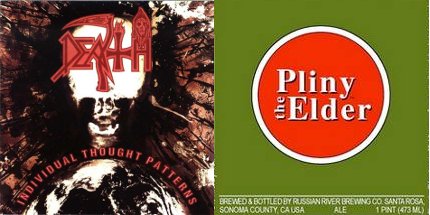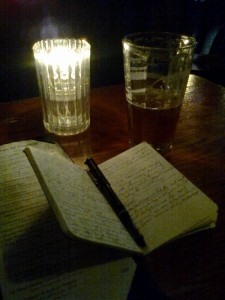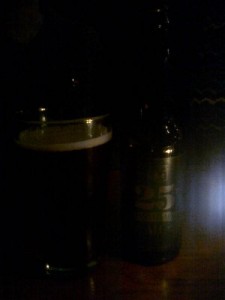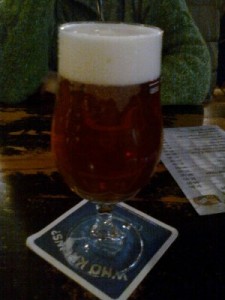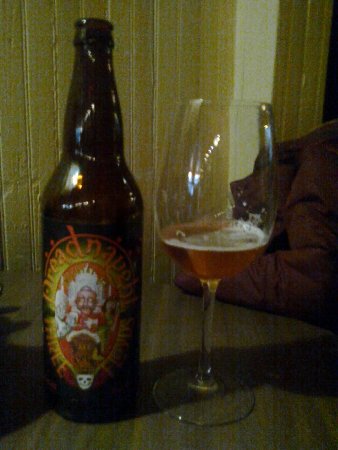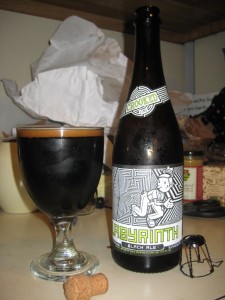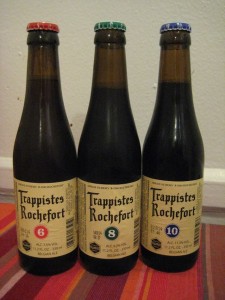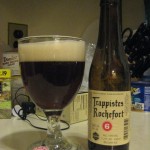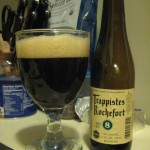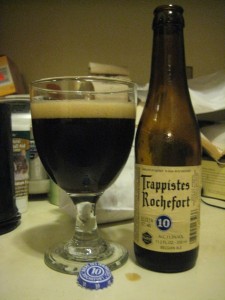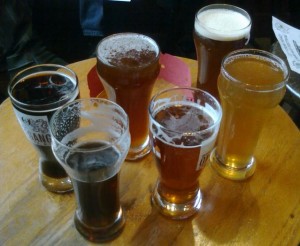While perusing the Chicago events listings on Beer Menus for the days we would be in town, I happened across a listing for a “Three Floyds Tap Takeover” at a place called The Beer Bistro. Along with Bell’s, Three Floyds is one of the breweries whose beers I determinedly seek out when in the Midwest. The temptation of nearly 20 lines of Three Floyds was too much to resist, so I studied the CTA maps and not only found my way out there, but managed to cobble together directions via text message so Martha could meet me.
The Beer Bistro strikes a great balance between local Chicago bar and beer nerd haven. To the left of the bar there hangs a framed Blackhawks jersey with “THE BEER BISTRO” and the number 1 sewn on it. Behind the bar there is not only the usual shelves of various bottles of hard alcohol, there is a six or seven tiered display of the many bottles of beer available. The taps are clustered mainly in the center of the bar, with the hand pump for the cask off at one end and a third clump of taps tucked away at the other end.
The food menu at Beer Bistro lists suggested beer pairings for a number of dishes. One that stuck out to me was macaroni & cheese paired with North Coast’s Old Rasputin imperial stout. Seems like an interesting pairing, though I’d be inclined to skip the mac & cheese and go right for the stout.
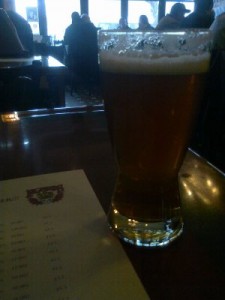
Owde Engwish Barley Whine. No typos, I swear.
After scanning the tap list and crossing out anything that was either a style that fails to move me (e.g. the Gumball Head wheat beer), something that didn’t seem special enough given the limited time I had (the Gold Leader lager), or something that could be found easily at other places in Chicago (the omnipresent and excellent Alpha King pale ale), I decided to start off with the Owde Engwish Barley Whine, which was supposed to be an English style barleywine. Generally, the difference between American and English barleywines is chalked up to the higher hopping rates of the former, though I think hop selection plays a major role as well. English styles traditionally go with earthy, vegetal hops like East Kent Goldings and Fuggle that reign in the sweetness of the abundant malts and provide a pleasant counterpoint. American barleywines typically use a lot of American hops, which means you get a lot of grapefruit, apricot and pine flavors mixing in with the sweet malt, and it’s not a mix that works in my opinion.
My first impression of the Owde Engwish is an excellent earthy aroma that suggests Goldings hops. This is followed by syrupy sweet malt flavors balanced well initially by a light dose of hop bitterness that turns a bit prickly before vanishing in the finish. The more I drank, the more bitter this became. I have a feeling the hops would mellow quite nicely with age and make this quite interesting.
Up next was the Hell’s Black Intelligencer, an oatmeal stout brewed with Intelligentsia Coffee and named for a line from Shakespeare’s Richard III. The coffee was the first thing to strike me, as my glass smelled like it was full of freshly roasted and ground coffee beans. The mouthfeel was wonderfully thick and velvety, as an oatmeal stout should be, with a shitload of roast barley flavor. Possibly a bit thin in the finish with something of an oily feel due to the oats and coffee? With the fairly low ABV and bitterness, you could easily drink quite a lot of this.
Three women walked in and looked around at an unusually crowded bar on a Wednesday night. “It’s all men!”, one exclaimed. The second asked, “What night is it? Wednesday?” The third observed, “It’s definitely not Ladies’ Night.” Surely there’s some sort of commentary about beer nerds in there….
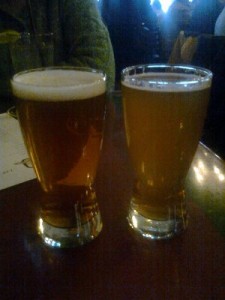
Dreadnaught on the left, Arctic Panzer Wolf on the right.
Martha walked in a few minutes later, upping the XX:XY ratio in the bar ever so slightly. She checked out the menu and we decided to order a pair of double IPAs, the Dreadnaught, which I wrote about previously on this blog, and the Arctic Panzer Wolf, which Three Floyds describes as a “massive IPA.”
The Arctic Panzer Wolf is very, very pale, almost straw yellow like a light lager. The body is thin as well, with a early blast of vegetal bitterness that fades to a mildly bitter finish. Not as bitter as you would expect for 100 IBUs, and fairly sessionable for being 9.5% ABV. It reminded me of Stone’s Ruination quite a bit — take that as you will.
The Dreadnaught was noticeably fuller in body that the Arctic Panzer Wolf, with what seemed like an almost syrupy flavor in comparison. My notes say simply, “FUCKING DELICIOUS!!” I firmly stand by that statement.
It would have been fun to stay and sample some more of the wonderful tap selection, especially since a Three Floyds appearance in NYC is quite rare, but we had to get all the way across town for a dinner meetup with friends. I will definitely keep the Beer Bistro on my list for future visits to Chicago.

